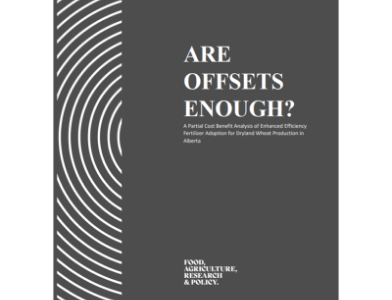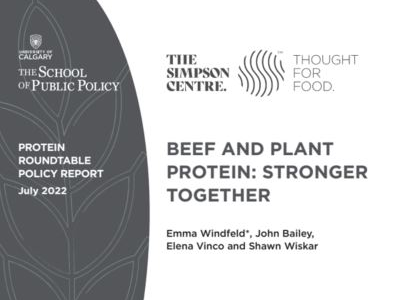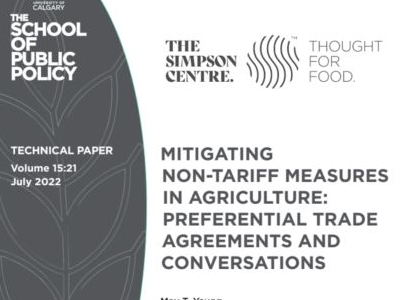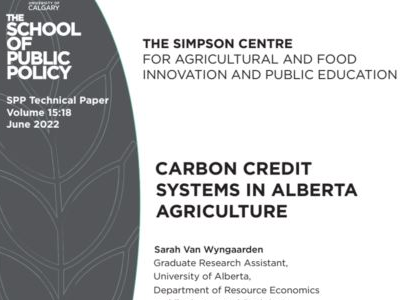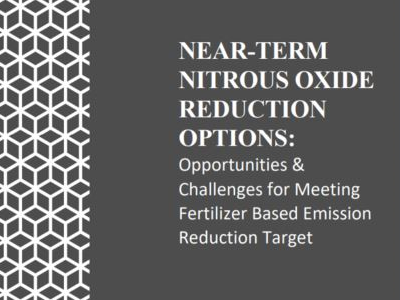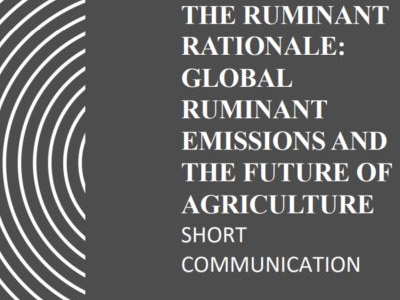Publications
A better understanding of the additional costs and potential benefits to producers is needed to meet Canada’s fertilizer-based emission reduction target through policies that incentivize on-farm EENF adoption. This research conducts a partial cost-benefit analysis for dryland wheat production in Alberta and EENF use. The research uses a modified version of Canada’s National Inventory Report Methodology to estimate direct fertilizer based N2O emissions. Monte Carlo simulation is used to estimate field-level emissions using a combination of township-level weather and risk zone-level production data. The costs and benefits of EENF adoption to producers were evaluated by estimating potential changes in net revenue, under a business-as-usual scenario and when carbon offsets are provided at a value of $50 and $170 per tonne of CO2eq.
While there a high degree of spatial variability is reflected in our results, the research indicated generally low base emissions across the province with approximately 90 percent of the simulated field level observations below 1.0 kg N2O emissions per hectare. Low per hectare average emissions will pose a major challenge to the development of an effective carbon offset program for N2O reductions, due to limited potential revenue generation relative to the cost of adoption. Estimated change in net revenue was highly dependent on the production risk zone and EENF product type used, suggesting limited effectiveness of a one-size-fits-all policy.
Monday, October 31, 2022
Nataliia Arman, Joshua Bourassa, Elena Vinco, Nicole Morrison, and Guillaume Lhermie
The roundtable of protein industry stakeholders was hosted by the Simpson Centre for Food and Agricultural Policy, an applied research policy institute at the University of Calgary’s School of Public Policy, whose goal is to mobilize research for better policymaking and decision-making to realize a more sustainable agricultural industry. Discussing the challenges and opportunities for the beef and plant protein industries, the participants agreed that working together would offer many benefits.
By presenting a united front, the protein industry has a better chance of lobbying governments for mutually beneficial changes, attracting more investments for infrastructure to increase efficiency and reliability, educating consumers on the synergies between the industries and branding Canadian protein as a sustainable, reliable and abundant market. Branding is a key factor in the protein market — consumers, investors and governments need to see the plant and beef protein sectors as partners, not competitors. They need factual information from the industry — rather than be influenced by misperceptions spread by social and mass media — to be satisfied with the agriproducts being produced and with the methods of production.
The roundtable participants cited one example of a synergy with benefits on multiple levels — using the by-product from plant protein production to feed cattle. This helps with sustainability in both the beef and plant protein industries, particularly with current global supply chain issues brought on by drought, conflict and other factors. It is also environmentally friendly and demonstrates that the industries can work together for each other’s benefit. This type of innovative synergy would also improve consumers’ perceptions of the beef and plant protein industries, besides driving investment and expansion.
Governments need to consider the opportunities that a unified protein market can provide for Canada. A strong, sustainable protein market has the potential for exponential growth, particularly with ongoing global supply chain issues and food security concerns.
Tuesday, July 26, 2022
Emma Windfeld, John Bailey, Elena Vinco, and Shawn Wiskar
Thursday, July 07, 2022
May T. Yeung
The Pan-Canadian Framework was implemented in 2016 to help meet emission reduction targets set out by the Paris Agreement. Carbon pricing is at the foundation of this framework, where Alberta has used a carbon-credit market to reduce emissions from large-scale emitters. Agricultural producers voluntarily participate in these markets through agricultural carbon offset protocols; regulated emitters can purchase agricultural carbon credits to meet their emission reduction requirements. The main goal of these agricultural protocols is to reduce on-farm emissions through the adoption of best management practices (BMPs), alongside providing producers with the potential benefit of earning additional revenue by selling carbon credits on the market. While producers have participated in the market for quite some time, the impact of the market on Alberta agricultural producers is unknown. The main objective of this paper is to understand this impact by analyzing two considerations: 1) emission reductions (or removals) from agricultural protocols; and 2) economic benefits to producers from participating in the carbon offset market. After a case study of current agricultural carbon offset protocols, the results suggest producers are mainly participating for the economic benefits stemming from the adoption of BMPs, rather than the potential revenue from selling carbon credits on the market. Results also show protocols have high emission reduction potential, but this analysis was limited due to a lack of publicly available data. The most significant observation is that the majority of protocol emission reductions come from one protocol, the Conservation Cropping Protocol. The remaining agricultural protocols have seen minimal uptake in participation, specifically from livestock producers, which is concerning given the retirement of the Conservation Cropping Protocol on December 31, 2021. The main consideration will be addressing current protocol shortcomings to ensure producers are willing and able to participate in the market.
Tuesday, June 14, 2022
Sarah Van Wyngaarden
Increasing pressure to expand output while maintaining or decreasing input and land use has placed farmers in a difficult position. The increase in fertilizer use to support growing yields and soil deficiencies in Canada lead to a significant spike in nitrous oxide emissions over the past 18 years. In 2020, the federal government of Canada introduced the first emission reduction target specific to the agricultural sector, aiming for a 30 percent reduction of inorganic fertilizer-based emissions by 2030. Agriculture and Agri-Foods Canada released a discussion paper in 2022, supplementing the federal government’s target with practical strategies and recommendations for farmers to adopt with associated changes and trade-offs, in order to reach the target. This systemic review of meta-analytical studies based explores the potential impact of 4R stewardship adoption and other mitigation strategies, including biochar, irrigation, and the use of legumes in crop rotation, on N2O emissions in Western Canada. Results were mixed, likely due to the interrelationships between environmental and soil factors in the nitrogen and hydrological cycles. Overall, enhanced efficiency fertilizers were identified as the most advantageous and applicable practices, with less applicable practices like biochar and micro irrigation also reducing N2O emissions. In order to improve N2O emission measurements and reflect the adoption of all mitigation strategies, Canada’s N2O accounting methodology should be updated before the 2030 target deadline.
Friday, May 20, 2022
Joshua Bourassa, Luc Fourner, Elena Vinco
The role of domesticated ruminants on a global scale cannot be understated, despite sweeping generalizations that oversimplify complex and intricate cattle and livestock systems existing from local to multi-national levels. Grazing and mixed systems, predominantly in the global south, are a crucial and necessary component of rural socio-economic structures and provide a source of food security and livelihood for small-holder and sustenance farmers. Ruminant production, specifically the emissions associated with dairy and beef cattle production, is a highly polarizing and contentious topic in climate change discourse. Current and potential forthcoming challenges and opportunities will require changes and possible trade-offs, optimizing transition risk to ensure future stability and longevity. Going forward, novel technologies and advancements in animal breeding and animal diet can reduce emissions and contribute to global and national emission reduction targets.
Thursday, May 19, 2022
Elena Vinco

